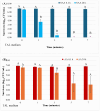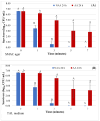Acid Adaptation Enhances Tolerance of Escherichia coli O157:H7 to High Voltage Atmospheric Cold Plasma in Raw Pineapple Juice
- PMID: 38930513
- PMCID: PMC11205674
- DOI: 10.3390/microorganisms12061131
Acid Adaptation Enhances Tolerance of Escherichia coli O157:H7 to High Voltage Atmospheric Cold Plasma in Raw Pineapple Juice
Abstract
Pathogens that adapt to environmental stress can develop an increased tolerance to some physical or chemical antimicrobial treatments. The main objective of this study was to determine if acid adaptation increased the tolerance of Escherichia coli O157:H7 to high voltage atmospheric cold plasma (HVACP) in raw pineapple juice. Samples (10 mL) of juice were inoculated with non-acid-adapted (NAA) or acid-adapted (AA) E. coli to obtain a viable count of ~7.00 log10 CFU/mL. The samples were exposed to HVACP (70 kV) for 1-7 min, with inoculated non-HVACP-treated juice serving as a control. Juice samples were analyzed for survivors at 0.1 h and after 24 h of refrigeration (4 °C). Samples analyzed after 24 h exhibited significant decreases in viable NAA cells with sub-lethal injury detected in both NAA and AA survivors (p < 0.05). No NAA survivor in juice exposed to HVACP for 5 or 7 min was detected after 24 h. However, the number of AA survivors was 3.33 and 3.09 log10 CFU/mL in juice treated for 5 and 7 min, respectively (p < 0.05). These results indicate that acid adaptation increases the tolerance of E. coli to HVACP in pineapple juice. The potentially higher tolerance of AA E. coli O157:H7 to HVACP should be considered in developing safe juice processing parameters for this novel non-thermal technology.
Keywords: Escherichia coli O157:H7; acid adaptation; cold plasma; pineapple juice; sub-lethal injury.
Conflict of interest statement
The authors declare no conflicts of interest.
Figures




References
-
- Grand View Research Fresh Fruits Market Size & Share|Industry Report. In Market Analysis Report. 2023. [(accessed on 10 April 2024)]. Available online: https://www.grandviewresearch.com/industry-analysis/fresh-fruits-market-....
-
- Technavio Juices Market—Size, Share, Growth, Trends, Industry Analysis 2027. Dec, 2022. [(accessed on 10 April 2024)]. Available online: https://www.technavio.com/report/juices-market-industry-analysis.
-
- Dewanti-Hariyadi R., Maria A., Sandoval P. Microbiological quality and safety of fruit juices. Food Rev. Int. 2013;1:54–57.
-
- Danyluk M.D., Goodrich-Schneider R.M., Schneider K.R., Harris L.J., Worobo R.W. Outbreaks of Foodborne Disease Associated with Fruit and Vegetable Juices, 1922–2010: FSHN12-04/FS188. 2012. [(accessed on 4 March 2024)]. Available online: https://journals.flvc.org/edis/article/download/119658/117576.
LinkOut - more resources
Full Text Sources

